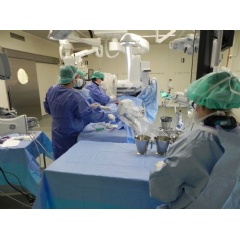Repairing a 100-year-old heart
Less invasive procedures grow more popular as populations age
In 1990, the world was home to 95,000 centenarians, or individuals over 100-years-old. By 2015, that number had quadrupled to nearly half a million and by 2050, experts project the population will swell to over 3.7 million globally.2
With the population composition changing so dramatically, many doctors across the world are finding ways to adjust their treatment approach for elderly patients and opting for less invasive procedures.
One condition that is prominent in the aging population is aortic stenosis, which can cause breathlessness and chest pain and occurs when the aortic valve narrows and restricts blood flow. Left untreated, it can lead to serious heart problems or even death.4 There are many ways to treat this medical condition, including stopping the heart, or opening the chest to repair or replace the diseased aortic valve. However, for older patients, these options pose a variety of risks.
That’s why many doctors are turning to transcatheter aortic valve implantation (TAVI), a minimally-invasive procedure in which doctors create a small incision in a blood vessel, insert a catheter and deliver a replacement valve to the valve site through a catheter. When done correctly, there are no major cuts or chest bones manipulated in the process and it puts less strain on the body.[1]The procedure was initially developed for more fragile patients and is typically performed on individuals between 80-95 years of age (sometimes younger depending on the risk profile).
Dr. Christian Butter[2], a cardiology specialist with more than 30 years of experience at the Brandenburg Heart Center in Germany, recently treated a centenarian with aortic stenosis.
“About two years before he came to me, he had been rejected for surgery because of the huge risk associated with his age – he was well over 100-years-old at the time.” Dr. Butter explained. “For quite a while, we discussed whether it made sense to perform any type of surgery at all considering his age, but he felt strongly that it was worth the risk.”
The Brandenburg Heart Center performs more than 400 TAVI procedures a year. The procedure is growing increasingly popular in many countries around the world as the population ages. Between 2008-2014 alone, 48,353 TAVI procedures were performed in Germany alone[3].
“Replacing the heart valve without sutures and with the smallest possible incision poses a much lower risk to the patient,” said Dr. Butter. “In only 1% of cases is there such a severe complication during the procedure that we quickly have to turn to open heart surgery.”
After weighing the risks, Dr. Butter decided to proceed with the TAVI on the patient. As with all TAVIs, it was critical that this procedure took place in a safe, flexible, and sterile environment for patients and clinicians, which is why the Brandenburg Heart Center is equipped with two Hybrid ORs with Discovery IGS 730 angiography systems. This set-up allows for complete patient access and the ability to accommodate a wide range of procedures, from complex interventional to surgical procedures.
“In my opinion, no other system would have worked in this particular case. The technology helps us create a safe environment for the patient and it’s fully equipped for cardiac and interventional surgery. If there were to be any complications, we can quickly open the chest to save the patient’s life,” said Dr. Butter.
Dr. Butter performed the TAVI procedure on the 100+-year-old patient in the Hybrid OR by making a small incision in the patient’s arm and inserting a catheter. Then, using the Discovery™ IGS 730 and Valve ASSIST 2[4], to carefully plan the procedure, Dr. Butter was able to deliver a replacement valve on top of the patient’s old valve that was restricting blood flow.
Ultimately, the centenarian made a quick recovery, which Dr. Butter attributes to the minimally-invasive nature of this surgery.
------
[1] https://www.nhs.uk/conditions/aortic-valve-replacement/alternatives/
2 http://www.pewresearch.org/fact-tank/2016/04/21/worlds-centenarian-population-projected-to-grow-eightfold-by-2050/
4 https://www.sciencedirect.com/science/article/pii/S0914508715000738
[2] GE Healthcare has a research contract with Dr Butter. The statements by GE Healthcare’s customer described here are based on results that were achieved in the customer’s specific setting. Since there is no “typical” hospital and many variables exist, such as hospital size and case mix, there can be no guarantee that other customers or patients will receive the same results.
[3] “Transcatheter aortic valve implantation (TAVI) in Germany 2008-2014: On its way to standard therapy for aortic valve stenosis in the elderly?”, 2016. EuroIntervention: journal of EuroPCR in collaboration with the Working Group on Interventional Cardiology of the European Society of Cardiology 11(9):1029-1033
[4] The Valve ASSIST 2 solution includes TAVI Analysis, HeartVision 2 and requires AW workstation with Volume Viewer, Volume Viewer Innova. These applications are sold separately
( Press Release Image: https://photos.webwire.com/prmedia/6/234046/234046-1.jpg )
WebWireID234046
This news content was configured by WebWire editorial staff. Linking is permitted.
News Release Distribution and Press Release Distribution Services Provided by WebWire.
